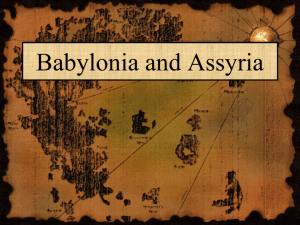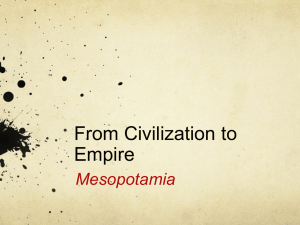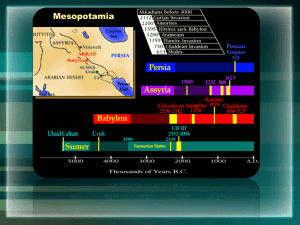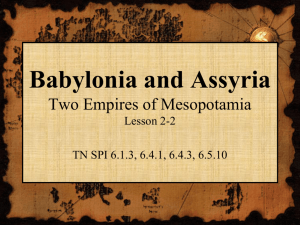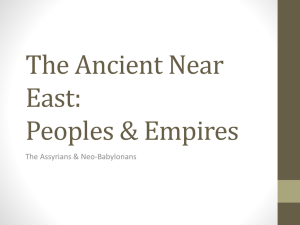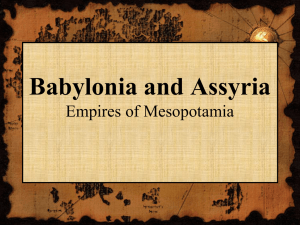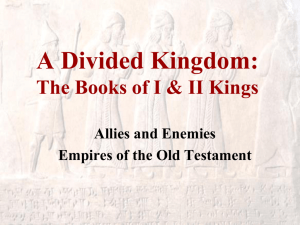The Lion Kings of Assyria
advertisement
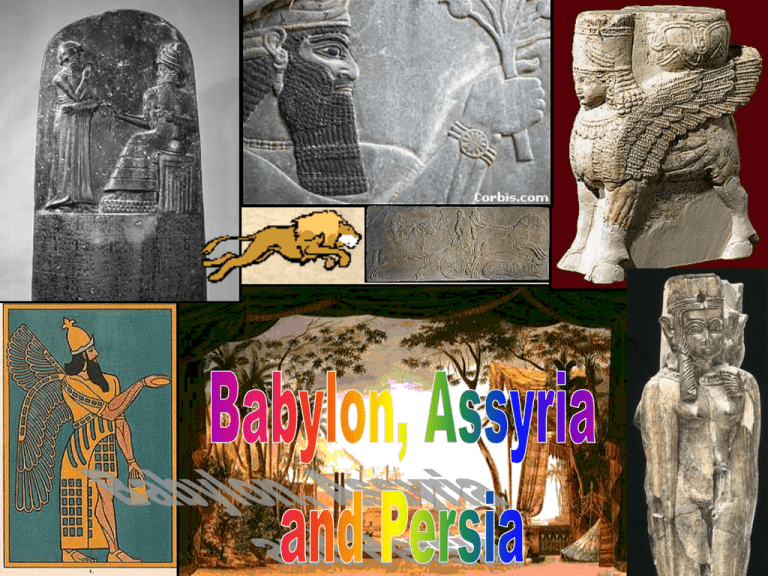
Identify the following: theocracy, polytheism, empire, The Code of Hammurabi, and the Babylonian Captivity. Explore and identify the chief contributions and characteristics of the Babylonians, Phoenicians, Assyrians, and Persians. Identify the following people: Sargon, Hammurabi, Nebuchadnezzar II, Ahura Mazda, Cyrus the Great, and Darius. Sumer 3000 BC Akkad 2340 – 2100 BC Babylon 1792-1750 BC Assyria 900 BC – 600 BC Chaldean Babylon 600 – 539 BC Persia 559 – 330 BC How many civilizations controlled the Mesopotamian region? •All speak a Semitic language. •Arable land near the Tigris/Euphrates rivers was managed with irrigation systems. •No natural barriers – prone to invaders. Map of the Region •Theocratic – kings rule as divine leaders. •Sargon – Powerful monarch (king) who led the Akkadians. •1st to establish an empire. That lasted 240 years. Copper Statue mask of Sargon. •Empire – a large territory or group of cities under a single leader or government. •Babylon was the center of culture and trade. People relied on a barter economy in order to exchange goods. •The civilizations in this region were polytheistic. •Cultural Diffusion - when a cultural trait, material object, idea, or behavior pattern is spread from one society to another. 1. What type of language was spoken in Babylon? 2. What impact did the lack of natural barriers have on this region? 3. Who was the 1st leader to establish an empire? 4. Which city was the most cosmopolitan? 5. Were the people in this region monotheistic, or polytheistic? •Ruled a strong Babylonian Empire. •He established the 1st code of laws called the “Code of Hammurabi.” •He built temples, encouraged trade, and revived Babylon’s economy. •Hammurabi defeated many armies, and was known as the “Sun of Babylon.” •He led the “Man of War” army. These soldiers carried axes, spears, and daggers made of copper or bronze. •His most important contribution – the 1st code of laws. •Hammurabi’s laws were carved on stones, and placed in the center of all Babylonian cities. King Hammurabi receiving the code. •The laws were the same for all cities he ruled. •Strict justice system and consumer protection laws. Hammurabis’ Court •Severe penalties for breaking the law. •Retaliation was key. •An “Eye for an eye and a tooth for a tooth.” This woman was one of the Chief judges under Nebuchadnezzar II. •If a Judge ruled poorly, he paid a fine and lost his position. •The Assyrian “kings” took the title of “Stewards of the Gods.” King Ashurbanipal left, and the Lion hunting relief to the right. Wikipedia Commons •War-like kings of Assyria took over the region around 700 BC. •By 650 BC, the Assyrians had defeated Syria, Palestine, Babylon, Egypt and Anatolia. Map showing the extent of the Assyrian Empire. Courtesy of Wikipedia Commons. •They established an empire that lasted about 300 years. •The army and its kings were infamous. •King Sennacherib was recorded to have sacked 89 cities, and 820 villages. King Sennacherib laying siege to the city of Lacdhish in Palestine. •He burned Babylon and killed most of the city’s people. •“3,000 of their troops, I felled with weapons…I cut off their hands to the wrist, I cut off their noses, ears and fingers; I put out their eyes, and burned their young men and women to death.” King Ashurbanipal lays siege to a city. - King Ashurbanipal •Army was well-organized and efficient. The Assyrian army laid siege to this city by crossing a river using inflated animal skins. •Infantry, cavalry and horse drawn chariots gave the Assyrians complete power in the region. •1st equipped with iron swords, spears and shields. •Great Military Engineers - 1st to use catapults and siege weapons. •Infamous for their cruelty. Smashed dams, looted towns, posted the heads of their enemies on stakes on the tops of city walls. •The Assyrian kings built extravagant palaces. •Established the first library at Nineveh. •Started the 1st postal network with horse men to relay messages. Assyrian King Ashurbanipal above, built the great library at Nineveh. Photo courtesy of Wikipedia Commons. 1.What were Hammurabi’s laws called? 2.How would you describe these laws? 3.What was Hammurabi’s army nicknamed? 4.How would you describe the Assyrian kings? 5.Which civilization is best known for the cruelty of its army? •King Nebuchadnezzar II, re-built Babylon and made it the center of his empire. •Nebuchadnezzar is best remembered for his building of the Hanging Gardens and the Babylonian Captivity. •1 of 8 Gates built by King Nebuchadnezzar II. The Ishtar Gate •Dedicated to the goddess Ishtar, this inner gate was the processional entrance into Babylon. •In 597 BC, Israel fell to Nebuchadnezzar. Solomon’s temple was sacked and the Jews were enslaved and taken to Babylon. •They remained enslaved until 539. Jews taken captive back to Babylon. •This was called the Babylonian Captivity. •The Persians arose from a mountain tribe in S. Iran. •Within a single generation, they were established as the #1 power in the world. •They were known for their spectacular military success, their wealth and invincibility. •The Khorasan Highway – or the King’s Highway allowed the Persians to create the 1st multi-cultural empire in the world. The Persians were tolerant rulers, but each citizen was a subject of the king. •Cyrus the Great was an Indo European and Persian. (Iran) •He liberated the Jews and allowed them to return home. •He created a powerful Persian empire in 559 BC, that lasted until Alexander’s conquest in 330 BC. Cyrus the Great •Persian Kings had absolute power. •Divided empire into 20 satraps or provinces ruled by a governor. Painting of Baghdad. •Collected taxes, provided justice and security. Recruited soldiers for the king’s army. Darius’ Army – •10,000 men in the Cavalry. •Elite Infantry of 10,000 men called the “Immortals.” (Their numbers were never allowed to drop below 10,000). •The religion that developed in Persia was Zoroastrianism. •Zoroastrianism – monotheistic religion. •Believed in Ahura Mazda, the “Wise lord," and divine judgment. •In 330 BC, Alexander the Great will defeat the Persian King, Darius. •Key Battles – Issus Granicus, and Gaugamela. Alexander the Great •Alexander will go on to conquer the known world. 1.What kind of power did Persian kings have? 2.What nickname was given to Darius’ infantry? 3.What religion developed in Persia? 4.Who will finally defeat the Persians?

